Published / Exhibited Greek Mycenaean Jar, ex-Christies
Lot 17d
About Seller
Artemis Fine Arts
686 S Taylor Ave, Ste 106
Louisville, CO 80027
United States
Selling antiquities, ancient and ethnographic art online since 1993, Artemis Gallery specializes in Classical Antiquities (Egyptian, Greek, Roman, Near Eastern), Asian, Pre-Columbian, African / Tribal / Oceanographic art. Our extensive inventory includes pottery, stone, metal, wood, glass and textil...Read more
Categories
Estimate:
$14,000 - $21,000
Absentee vs Live bid
Two ways to bid:
- Leave a max absentee bid and the platform will bid on your behalf up to your maximum bid during the live auction.
- Bid live during the auction and your bids will be submitted real-time to the auctioneer.
Bid Increments
| Price | Bid Increment |
|---|---|
| $0 | $25 |
| $300 | $50 |
| $1,000 | $100 |
| $2,000 | $250 |
| $5,000 | $500 |
| $10,000 | $1,000 |
| $20,000 | $2,500 |
| $50,000 | $5,000 |
| $100,000 | $10,000 |
| $200,000 | $20,000 |
About Auction
By Artemis Fine Arts
Feb 13, 2020
Set Reminder
2020-02-13 10:00:00
2020-02-13 10:00:00
America/New_York
Bidsquare
Bidsquare : Exceptional Antiquities, Asian, Ethnographic
https://www.bidsquare.com/auctions/artemis-gallery/exceptional-antiquities-asian-ethnographic-4848
An important one-day auction featuring museum-worthy examples of Egyptian, Greek, Roman, Etruscan, Near Eastern, Far East / Asian, Pre-Columbian, African / Tribal, Oceanic, Native American, Spanish Colonial, Russian, Fossils, Ancient Jewelry, Fine Art, so much more! Artemis Fine Arts info@artemisgallery.com
An important one-day auction featuring museum-worthy examples of Egyptian, Greek, Roman, Etruscan, Near Eastern, Far East / Asian, Pre-Columbian, African / Tribal, Oceanic, Native American, Spanish Colonial, Russian, Fossils, Ancient Jewelry, Fine Art, so much more! Artemis Fine Arts info@artemisgallery.com
- Lot Description
Ancient Greece, Mycenaean Period, Late Helladic II to Late Helladic III, ca. 1400 to 1100 BCE. A fabulous, wheel-thrown pottery jar of a traditional utilitarian form with a protruding ring base, a compressed spherical body with a gently rounded shoulder, a pair of stirrup-shaped handles arching to the top of a central false spout, and a functional spout with a thick rim off-set along the shoulder. The cream-slipped vessel exhibits an attractive minimalism with solid swaths of red-brown pigment adorning the handles, a false spout, and a functioning spout, with two sets of thin stripes enclosed within a pair of broad bars, and a solid ring of pigment around the foot. A fantastic example of everyday pottery artistry from a time when Mycenae was at its peak of influence in the Mediterranean. Size: 4.5" W x 3.8" H (11.4 cm x 9.7 cm).
The stirrup jar is one of the most ubiquitous vessel shapes of the Late Helladic Period. Although the type was originally a Minoan innovation, it gained great popularity in the Mycenaean world. Its moniker derives from the form of the handles that flank a false spout. These petite vessels were perhaps for storing oil, while the larger versions would have perhaps contained wine. The design would have been ideal for sealing during transport, to prevent spillage and the evaporation of scented perfumes. The red-brown-painted concentric circles along the body are typical for small stirrup jars in this period.
This vessel was part of the extensive collection of Luigi Palma di Cesnola, the first Director of The Metropolitan Museum of Art. The museum periodically deaccessioned items from this unparalleled collection, and this particular vessel was deaccessioned in 1916.
Published in: Boulter, C.G. and K.T. Luckner. "Corpus Vasorum Antiquorum." The Toledo Museum of Art, Toledo, 1984, Fasc. 2, p. 1, pl. 61.3.
Beazley Archive Database, no. 9001869
This piece is possibly included in "The Terracottas and Pottery of the Cesnola Collection of Cypriote Antiquities," New York, 1895, no. 2, p. 75 (possibly no. 542, 544, 546, 550-556, 565-566, 568 or 570).
Provenance: private Connecticut, USA collection; ex-Christie's, New York, Online "Storied Treasures: Antiquities from the Toledo Museum of Art" auction (sale 14572, October 19-26, 2016, lot 28); ex-Edward Drummond Libbey (1854-1925) collection, Toledo, Ohio, USA, gifted to The Toledo Museum of Art in 1916, accession number 1916.115; exhibited from 1873 to 1916 at The Metropolitan Museum of Art, New York, New York, USA; ex-Luigi Palma di Cesnola (1832-1904) collection, New York, New York, USA, the first Director of The Metropolitan Museum of Art, 1868-1873.
All items legal to buy/sell under U.S. Statute covering cultural patrimony Code 2600, CHAPTER 14, and are guaranteed to be as described or your money back.
A Certificate of Authenticity will accompany all winning bids.
We ship worldwide and handle all shipping in-house for your convenience.
#152758Professional repairs to handles, central false spout, and functioning spout, with in-fill to a few small areas around body and resurfacing and light overpainting along break lines. Minor abrasions and nicks to base, body, handles, and spouts, with areas of fading and darkening to original pigmentation, and light encrustations. Nice earthen deposits and great traces of original pigment throughout.Condition
- Shipping Info
-
All shipping is handled in-house for your convenience. Your invoice from Artemis Gallery will include shipping calculation instructions. If in doubt, please inquire BEFORE bidding for estimated shipping costs for individual items.
-
- Buyer's Premium



 EUR
EUR CAD
CAD AUD
AUD GBP
GBP MXN
MXN HKD
HKD CNY
CNY MYR
MYR SEK
SEK SGD
SGD CHF
CHF THB
THB















